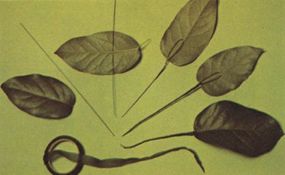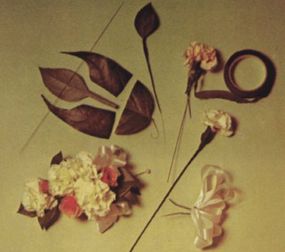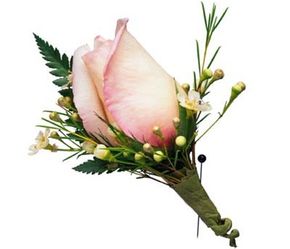How to Make a Corsage
Many different materials can be used for making corsages. Purchased material can be mixed with flowers and foliage from your garden or indoor plants.
The flowers should be bright and fresh and the greens should have a good color and substance. Make sure that the flowers and the greens have been conditioned by cutting the ends of the stems and putting them in a deep container of tepid water until they have taken up as much water as possible. This should be done at least three hours before working with the material.
Advertisement
What you will need:
- Flowers
- Greens
- Wire (No. 24 wire is a good weight, but No. 28 is better for more delicate flowers)
- Floral tape (1/2-inch wide for wrapping the stems and wires; it can be green, brown, or a harmonizing color)
- Ribbon (1/2-inch wide in a harmonizing or contrasting color to finish off the corsage or fill holes in the design)
- Large-headed corsage pins.
Steps in making a corsage:
Step One: Wire each blossom and each leaf separately, this makes the corsage easier to arrange. Wire blossoms either by sticking the wire through the calyx, the thick green part right underneath the flower, or by poking a wire through the center of the flower.

On stiff-stemmed flowers, leave one-half to three-quarters of an inch of the stem. With flowers like daisies, push a wire up through the center of the flower, bend the top into a hook, and pull it back into the blossom. If some flowers, such as carnations, are too large, they can be split and each part treated as an individual blossom.
Also, if a leaf is too large, a smaller leaf can be cut from the tip end. It is also possible to create flowers by combining several leaves.
In the '50s, "glamelias" were constructed from gladiolus and rosebuds; a rosebud or gladiolus bud was inserted into a gladiolus blossom and served up with a lot of ribbon. These corsages were even more popular than orchids.
Step Two: Individual leaves are wired by slipping the wire through the base of the leaf and wrapping it down the stem.
Step Three: After you have wired the flowers and the leaves, wrap them with tape. Start wrapping next to the blossom or leaf base.
Step Four: Combine the leaves and the flowers into a corsage. Tie the parts together with wire or tape. Cut the wrapped wire stems and either leave them straight or curl the ends. Add a bow, if desired, and a couple of large-headed corsage pins.

Step Five: To protect the flowers and cut down on moisture loss until it is time to wear them, put the corsages in closed plastic bags in the refrigerator.
Ready to take the next big step? In the following section, learn how to make a bouquet.
Inspired by cut flowers? To learn more about gardening, see:
